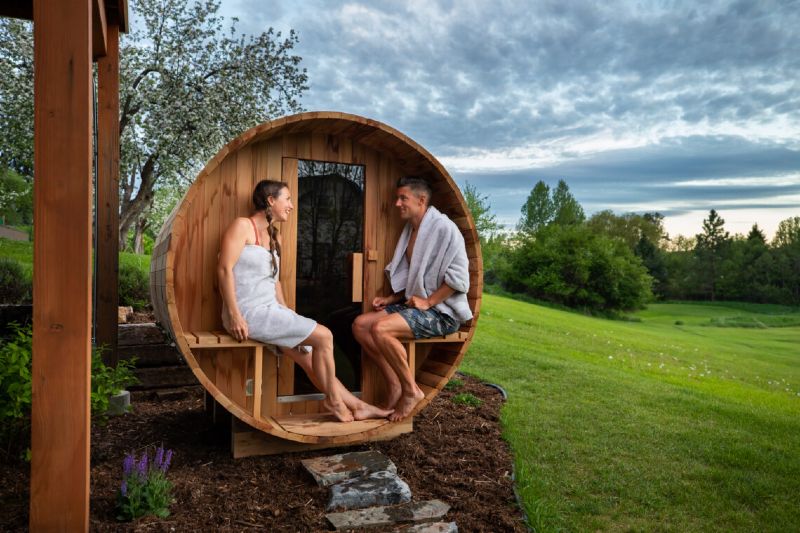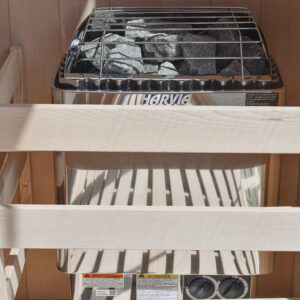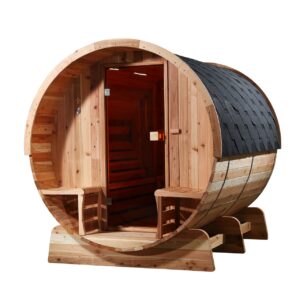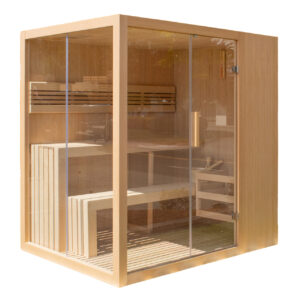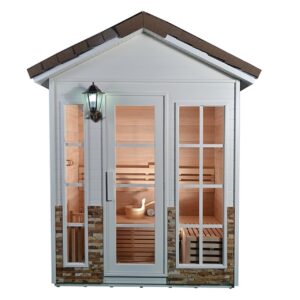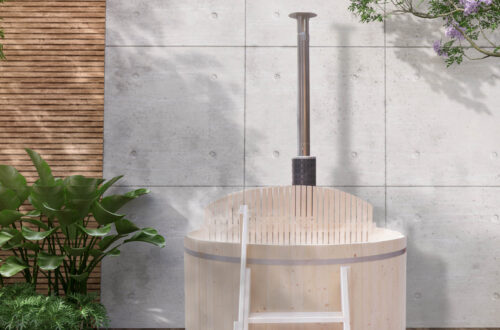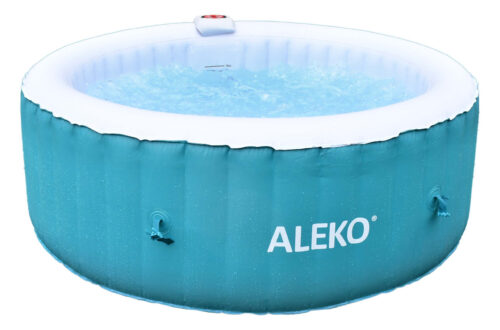For many people, home is their sanctuary. It’s where they go to relax and rejuvenate. It’s no wonder then that many people are starting to enhance their space by bringing the spa experience home and investing in self-care additions like saunas.
If you are considering whether it’s worth adding a sauna to your home environment, we encourage you to read below to discover the benefits of home saunas, and how to choose the right one for your space.
Why Invest in a Home Sauna?
Home saunas are a wonderful addition to most spaces. They offer more privacy than public saunas, and allow you to create customized experiences. If you’re still on the fence on whether you should bring a sauna to your space, consider these factors:
Therapeutic Benefits
There are emerging studies that suggest saunas provide health benefits. Harvard Health Publishing’s recent 2020 article shares that saunas benefit your heart health, as long as you practice recommended sauna safety guidelines and do not have heart disease or uncontrolled high blood pressure.
In a study published by Mayo Clinic Proceedings, research has found that “Beyond pleasure and relaxation, emerging evidence suggests that sauna bathing has several health benefits, which include reduction in the risk of vascular diseases such as high blood pressure, cardiovascular disease (CVD), stroke, and neurocognitive diseases; nonvascular conditions such as pulmonary diseases including common flu; mortality; treatment of specific skin conditions; as well as pain in conditions such as rheumatic diseases and headache.” You can learn more about this research here.
Privacy or Social Connection — You Choose
Whether you wish to relish in a quiet moment to yourself or relax while catching up with a loved one, in-home saunas give you the flexibility to enjoy your sauna session the way you prefer.
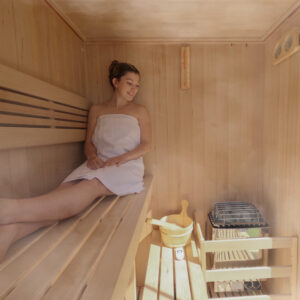 Self-Care that Fits Your Schedule
Self-Care that Fits Your Schedule
While you can certainly enjoy saunas that are available at local spas, they typically require you to make reservations weeks in advance, as well as travel time. Gym saunas are typically available without reservation, but still require you to travel back and forth. An in-home sauna, on the other hand, allows you to enjoy self-care any day of the week, even on a busy schedule. If you only have 20 minutes, you can hop in the sauna for 5 to 10 minutes quick without sacrificing other activities planned for the day.
Customized Sessions
Do you prefer sitting in hotter, dryer saunas? How about adding essential oils for aromatherapy? Having your own sauna puts you in the driver’s seat so that each session helps you unwind your way.
More Peace of Mind
The spread of germs and unsafe sanitation practices are a concern for many people when visiting public saunas. With an in-home sauna, you can be more at ease knowing strangers don’t have access to your space and that you are in control of setting the hygienic standards to keep your sauna clean.
Increased Home Value
Think of saunas as an investment. While there is a higher up-front cost, saunas pay off in the long run by enhancing your home environment and increasing its overall value. If you want to take it to the next level, look for a cold plunge for sale for a complete warm-and-cold bathing experience.
Sauna Buying Guide
Once you’ve decided to invest in a home sauna, your next step will be to learn more about the various options available. Here’s a quick guide to help you find the best sauna to match your needs, preferences, space, and budget.
Property Restrictions
Before picking out your preferred style of sauna or considering details such as wood type, it’s first good to learn about any property restrictions that could impact your purchase decision. For example, how much space do you have inside your home or in your yard to fit a sauna? If you’re interested in having a smaller sauna, there are many location places that you can consider both inside and outside of your home — even a storage closet can be converted to fit a sauna if needed!
If you are choosing an indoor sauna, you’ll need to assess whether there is currently adequate ventilation in the area. If there isn’t proper ventilation now, don’t worry. You can make some adjustments to allow for increased airflow, such as adding an exhaust fan. For outdoor saunas, like our barrel saunas, research local regulations to ensure there aren’t any legal requirements prohibiting outdoor saunas in your neighborhood. Even if you can legally have an outdoor sauna in your yard, you might need to obtain a building permit first, so make sure you have all the proper paperwork filled out before proceeding with a purchase.
No matter where you place your sauna, you’ll need to ensure that you have a flat surface and a safe and reliable source of power. The necessary electrical connection that you’ll need will depend on the sauna and heater you choose, so keep that in mind as you’re doing your research.
Budget
Next, spend some time researching the costs of different types of saunas and determine your budget range. Quality traditional saunas typically cost anywhere between $3,000 – $15,000+ depending on the style, size, and materials used. Here are some additional factors to keep in mind:
- When planning your budget, remember to factor in the expense of any additional work that will be needed to complete your sauna assembly, such as electrical work or any remodel work.
- Some companies offer installation services for an additional fee. However, you can typically save quite a bit of money by assembling the sauna yourself, and just hiring an electrician to help install your heater.
While saunas are a big purchase, they are also meant to last for years, and they help increase the value of your home. Because of this, it’s best to avoid cheap options built from low-quality materials. We’ll share more on materials further below.
Indoor vs. Outdoor Saunas
Whether you choose an outdoor or an indoor sauna is mostly a personal preference and will also depend heavily on what is possible in your space. If you can install either option, consider where it feels most comfortable for you to access and use your sauna. If you live in an area with extreme temperatures, for example, you might prefer an indoor sauna to avoid having to endure freezing temperatures pre- and post-sauna session in the middle of winter.
Size and Capacity
The size of sauna you choose might depend on your budget and what your home can reasonably fit, but another factor to consider is how you prefer to enjoy your sauna. For example, would you prefer enjoying a serene moment alone or would you enjoy socializing in your sauna with family and friends in a 4-person barrel sauna?
When browsing saunas and reviewing each model’s details, be sure to note the interior and seated bench dimensions to get the most accurate estimate for capacity. Then, review the heater placement to assess whether the heater’s location will interfere with sitting anywhere, as that could reduce the amount of people who can enjoy the sauna together at one time. You’ll also want to consider who will be using the sauna regularly, as two adults will often take up more space than an adult and teenager.
Traditional vs. Infrared Saunas
There are two main types of saunas on the market today: traditional and infrared. The main difference between the two saunas is how they produce heat. Infrared saunas use infrared heaters to emit infrared light, while traditional saunas (following the traditional Finnish style) use electric heaters. In other words, traditional saunas heat the air around you, helping your body begin its natural cooling process in the form of sweating. Infrared saunas, on the other hand, heat your body using light, rather than heating up the room around you.
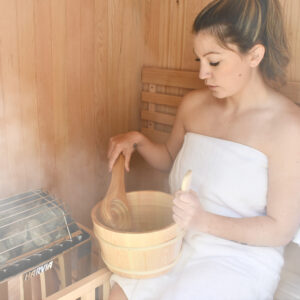 Another main difference between the two types is that traditional saunas can produce steam. Along with an electric heater, traditional saunas have rocks that you can pour water over to increase humidity levels. This increase in humidity then creates steam, which helps unclog sinuses and pores and helps promote circulation. If you prefer a steamier sauna, than a traditional option is your best solution. Even if you don’t prefer a steamy sauna session, you can still experience a dryer heat if you simply don’t pour water on the rocks during your session.
Another main difference between the two types is that traditional saunas can produce steam. Along with an electric heater, traditional saunas have rocks that you can pour water over to increase humidity levels. This increase in humidity then creates steam, which helps unclog sinuses and pores and helps promote circulation. If you prefer a steamier sauna, than a traditional option is your best solution. Even if you don’t prefer a steamy sauna session, you can still experience a dryer heat if you simply don’t pour water on the rocks during your session.
Lastly, unlike infrared models, traditional saunas do not emit electromagnetic fields, which can be harmful when emitted at high levels.
Wood Type
Hemlock and cedar are often considered the best type of wood for saunas, thanks to their natural resistance to humidity, changes in temperature, fungus, and decay. If you enjoy a rich, aromatic scent, cedar is a great option and can be used to enhance relaxation. Hemlock is a low-scented wood and is a better option if you have allergies.
If you are interested in browsing less expensive options, white pine is typically less pricey, but still a strong and sturdy wood.
Additional Materials
While wood is the primary material used to build a sauna, there are other pieces and materials you will want to consider, including the glass used for the windows and doors, lighting, and if you are choosing a traditional sauna, the electric heater.
For glass and light bulbs, make sure the material used can withstand high heat and will not be damaged during use. Tempered glass (sometimes referred to as “safety glass) is best for saunas because it is stronger than standard glass and less likely to break in extreme conditions. When reviewing sauna features, ask yourself whether you want the glass to be tinted for privacy.
For your heater, do some research on the brand used to ensure it is good quality and confirm that it meets the proper safety standards (is the heater ETL or UL certified?).
Sauna Accessories and Features
Saunas can be simple or come with a wide range of accessories and features that make them stand out from others. For example, does your sauna have shelves that you can attach to hang up towels and products? What kind of lighting does your sauna offer? You may be fine with a simple lamp to light up your sauna interior, or you might prefer colorful LED lighting to enhance the ambience of your space. Some come with auto-shut off features for additional safety. Others come with timers you can use to keep track of how long you have been using your sauna. While researching your options, decide which features are a must-have to help you narrow down your selection. Just keep in mind that the more features a sauna has, the more it typically costs.
Start Your Sauna Search Today
Saunas have been used to increase people’s well-being for thousands of years. Now, you can enjoy the therapeutic benefits that saunas provide any day of the week by bringing one into your home.
When you are ready to find the best sauna for your home, begin your search by browsing ALEKO’s selection of traditional saunas.
Barrel Saunas
Starting as low as $200/month
Indoor Saunas
Starting as low as $166/month
Outdoor Saunas
Starting as low as $225/month

